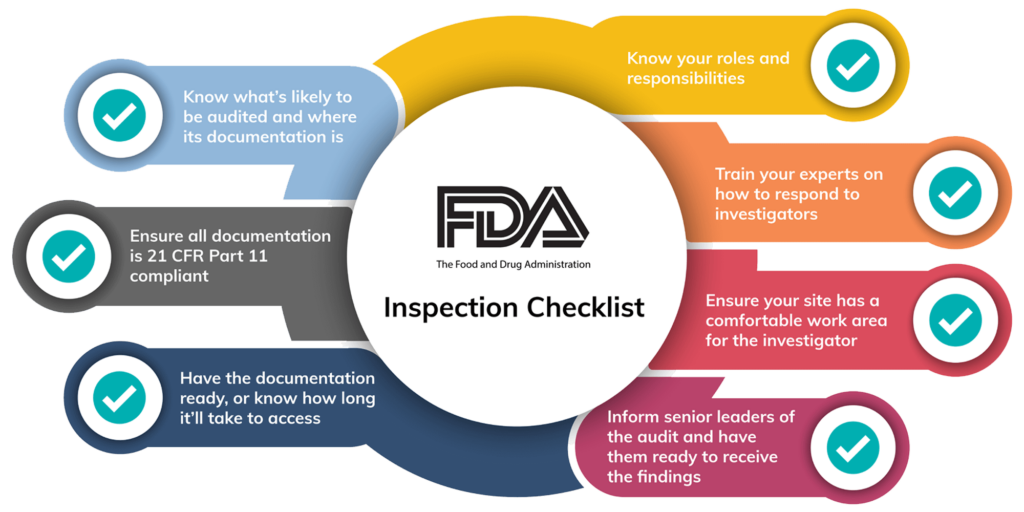
For many companies making medicines, medical devices, food products, or similar goods for the U.S. market, the U.S. Food & Drug Administration (FDA) is their chief regulator. The FDA routinely conducts audits and inspections at sites within the U.S. or abroad (when producing goods destined for the U.S. market).
Audits and inspections can be daunting, but when you’re prepared there’s nothing to fear. So how do you get ready for anything an investigator can throw at you? Here’s a handy FDA Inspection Checklist to help.
| Checklist |
|---|
| ✔ Know what’s likely to be audited and where its documentation is |
| ✔ Ensure all documentation is 21 CFR Part 11 compliant |
| ✔ Have the documentation ready, or know how long it’ll take to access |
| ✔ Know your roles and responsibilities |
| ✔ Train your experts on how to respond to investigators |
| ✔ Ensure your site has a comfortable work area for the investigator |
| ✔ Inform senior leaders of the audit and have them ready to receive the findings |
Step One: Know the Scope
Audits and inspections may be targeted or general, it’s important to know the scope before things get started. Most audits or inspections will have some warning before they begin, this is your time to identify what is most likely to catch the investigator’s interest.
When you know the scope, the next part is knowing where the relevant documentation is. Some companies still use paper-based practices and store their records offsite. Give notice to any third-party document manager that you may need quick access to your documents. Remember, not only must you provide requested documentation during an FDA inspection, but you must do so in a timely manner.
Step Two: Maintain Data Integrity
Any documentation must adhere to strict data integrity rules as part of FDA’s regulations. To be 21 CFR Part 11 compliant, you must follow the ALCOA+ guidelines:
| ALCOA+ | Expectation |
|---|---|
| Attributable | Who, when |
| Legible | Readable |
| Contemporaneous | Work time stamped when completed |
| Original | Complete raw data information (avoiding transcriptions) |
| Accurate | No errors and amendments are verified |
| Complete | Record is represented in its entirety |
| Consistent | Well-ordered and chronological |
| Enduring | Stored long-term |
| Available | Easily accessed for use |
Step Three: Access Your Documents
If your documents are paper, go get them, or be ready to get them. If they’re digital — which is highly recommended — make sure you know how to navigate to them. Kneat makes document accessibility easy for audits, with a ‘Collections’ staging area that allows for documents to be sent over for viewed by auditors. A Real-Time Requirements Traceability Matrix (RTM) also makes it easy to track documents and requirements throughout validation testing. Features like these can help you keep track of the documents you’ll need.
Step Four: Know Your Roles
Everyone involved in an FDA inspection has their part to play. Roles and responsibilities should be designated ahead of time so there’s no confusion when the investigator gets started.
Some important roles include:
- The Escort
- The Scribe
- Runners
- War Room Personnel
- Subject Matter Experts (SMEs)
We explore these roles in depth in our eBook, Audit Preparedness: Using Digital Validation to Be Ready for Anything .

Step Five: Train Your Experts
Every organization has subject matter experts (SMEs) with a wealth of knowledge about a given topic. These are the ones who will largely be responsible for answering technical questions from investigators. Make sure they’re prepared for the stress of an inspection by running through practice drills and providing training.
SMEs are recommended to:
- Be clear, truthful, and concise.
- Be calm and confident, but not aggressive.
- Be transparent, but not overshare.
Step Six: Create a Comfortable Working Area
An FDA Inspection is a physical investigation of a site, and the investigator will need a working area. Make sure there’s a quiet and comfortable place for them to set up shop. The site escort should always accompany them, and a scribe can run between the Audit War Room and the working area to provide documents and requests as needed.
Step Seven: Inform Leadership
Senior leaders of a site or organization should be present during an audit, it’s up to an organization’s own protocol as to how far up notice must go. When the FDA Inspection is over, a Form 483 may be issued with non-conformities. It’s crucial senior leaders be made aware and are part of the response. A Form 483 isn’t the end of the road, there’s still time to correct any mistakes found during an inspection.
Using Digital Validation for FDA Inspections
Digital tools are highly recommended for being Audit Ready and will significantly help your FDA Checklist activities. Kneat Gx is the industry leading digital validation solution, used by eight out of the Top 10 life sciences companies.
See how Kneat Gx can help you with all your validation needs, enshrine data integrity throughout your life cycle, and help you respond to audits better than ever.




